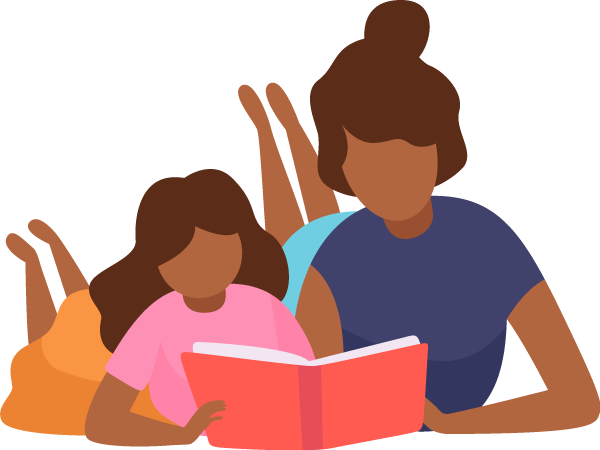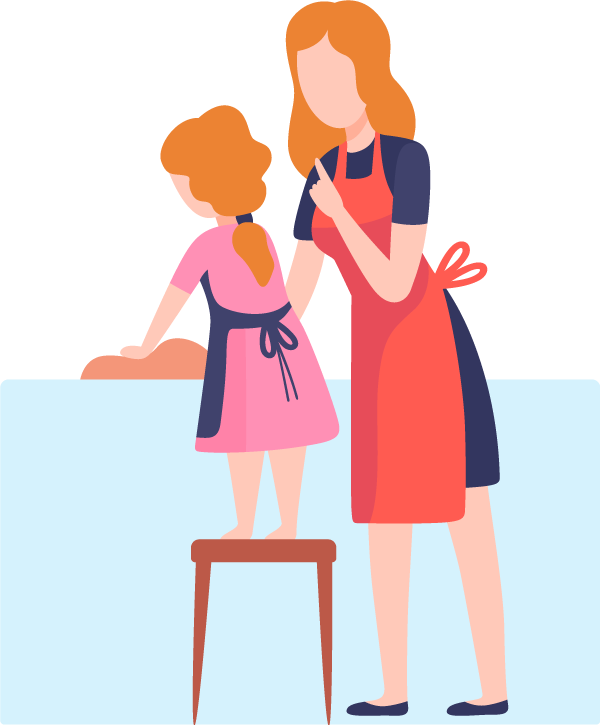-
About the RELs
+
-
For more than 50 years, the RELs have collaborated with school districts, state departments of education, and other education stakeholders to help them generate and use evidence and improve student outcomes. Read more
-
- Regions +
- Products
-
Topics
+
- Achievement Gap Career Readiness Charter Schools College Readiness COVID-19 Data Use Discipline Dropout Prevention
- Early Childhood Education English Language Learners Equity Literacy Mathematics Online Courses Postsecondary Education Principals
- Research Tools Rural Schools Social Emotional Learning Special Education Student Characteristics Teacher Effectiveness Teacher Persistence Teacher Recruitment
- Events
- Blog
- Connect with Us +
Home Products Supporting Your Child's Reading at Home
Supporting Your Child's Reading at Home
Third Grade: Recommendation 1: Developing Language
Expose your child to the formal language that is common in books and in school.
Talking While You Read

Having a conversation about a book will develop your child's vocabulary and build knowledge about the topic of that book. Whether you are reading a fairy tale, a picture book, an informational book, or any other text, you can engage in a discussion as you enjoy reading together.
It is best to choose books about topics which are interesting to your child. You can read books from your home or borrow a book from your child's classroom library, school library, or the public library. You can also access books on laptop computers, tablets, digital reading devices, and smartphones. Websites such as Project Gutenberg provide free access to books and mobile formats especially for smartphones. Don't forget to look through your smartphone's app store for free apps containing books for children.
Incredible Inferences
Key Points About the Video
- Mom describes what an inference is before they play the game.
- Mom asks kids to show evidence from the text to support their inference.
- Mom and kids have fun playing the game.
Incredible Inferences
Help your child make inferences by using evidence from what he or she reads to make a logical conclusion.
Summarize a Story
Key Points About the Video
- Mom and daughter discuss what a main idea is before beginning the activity.
- Daughter reads the beginning of the story, writes a summary of it, and then discusses the summary with Mom. This is repeated with the middle and the end of the story.
- Mom discusses the meanings of words that may be challenging to understand (despise).
Summarize a Story
Help your child summarize what he or she reads to support comprehension.
Summarizing Bookmark
Use this bookmark to engage your child in conversation about the main ideas and details of what you read together.
Books to Share
Here is a list of suggested book to practice summarizing. Although, you can summarize anything you read. Take turns reading or listen to your child read. Stop after a chapter, if a long book, and ask your child to tell you the main ideas and important details. You can do this at the end of a short book.
- Owen and Mzee: The True Story of a Remarkable Friendship by Isabella Hatkoff, Craig Hatkoff, Paula Kahumbu
- Goose and Duck by Jean Craighead George
- Koala Lou by Mem Fox
- The Tiny Seed by Eric Carle
- Ice Cream Elisha Cooper
Supporting Oral Language and Vocabulary Development

Oral language is the way we communicate with others through speaking and listening. Vocabulary knowledge is a crucial part of oral language and includes understanding the meaning of words, how to use them, and how to pronounce them.
Oral language practice will help your child expand his or her vocabulary. Children with strong oral language skills and larger vocabularies typically become better readers. The best ways to give your child a strong foundation for learning to read are to read to, talk to, and listen to your child every day. Talk about people you know, places you go, and experiences you have together. Writing with your child also helps with oral language development.
- Ask questions that require more than a yes or no answer. For example, instead of asking, "Did you have a good day?" ask, "What was your favorite part of school today?" Continue to ask questions about your child's response. If the answer was "Recess," ask, "Who did you play with?" "What did you do?" "How do you play that game?"
- When you speak with your child, model speaking in complete sentences and providing details. Use the words your child says and expand on them. For example, if your child points to a car and says, "Yellow car!" say, "That is a bright yellow car that is moving quickly! Where do you think that person is going?"
Dinner Table Talk
Key Points About the Video
- Adults listen to daughters and ask open-ended questions to extend the conversation.
- Family has fun discussing what they would invent and their favorite super power.
- Mom ensures that all family members have opportunities to participate in the conversation by asking each family member the same questions.
Baking Conversations
Key Points About the Video
- Caretaker describes how recipes are organized (ingredients and steps).
- Child reads the steps of the recipe and is actively involved in every step of the recipe.
- Caretakes uses words (for example, chill, dough, fluffy, batter, scoop) to describe what they are doing.
- Caretake describes the reason why they are doing specific things to deepen child's understanding of concepts (for example, the science of baking, why make a test batch, why place cookies near center of baking sheet).
Talking and Writing in the Kitchen
Use these questions, activities, and conversation starters to have fun while you talk and write in the kitchen.
Chatting About Chores
Key Points About the Video
- Mom and daughter discuss what chores are and why they are important.
- Mom talks about the meaning of responsibility.
- Mom is positive and has daughter determine her own chores, state why each chore is important, and write them on the chore chart.
Chatting About Chores
Use this activity to talk about and make a list of chores your child can do.
Synonyms and Antonyms
Key Points About the Video
- Dad makes sure son knows what a synonym and antonym are by having him give examples before beginning the activity.
- Dad explains meanings of words that may be unfamiliar (for example, courteous). Dad uses words in sentences that his son can relate to (for example, "Your sister comes into your room and ruins your Legos.")
- Dad asks son to use words in sentences to make sure he understands the meaning of each word.
Synonyms and Antonyms
Help your child practice identifying and writing synonyms and antonyms.
Talk About Words
Key Points About the Video
- Mom describes the meanings of the antonyms (opposites): stranger, relative.
- Mom relates the meanings of words to her daughter's experiences.
- Mom asks questions to prompt daughter to describe why she decides to place words where she does on the continuum.
- Mom helps daughter read unfamiliar words by giving her cues. For example, "That's a long a." (stranger) And, "Sound it out." (sob).
- Mom asks daughter to read all the words after they are placed on the continuum for another opportunity to practice reading.
Talk About Words
Deepen your child's understanding of related words and help enhance your child's vocabulary.
Connect with REL Southeast